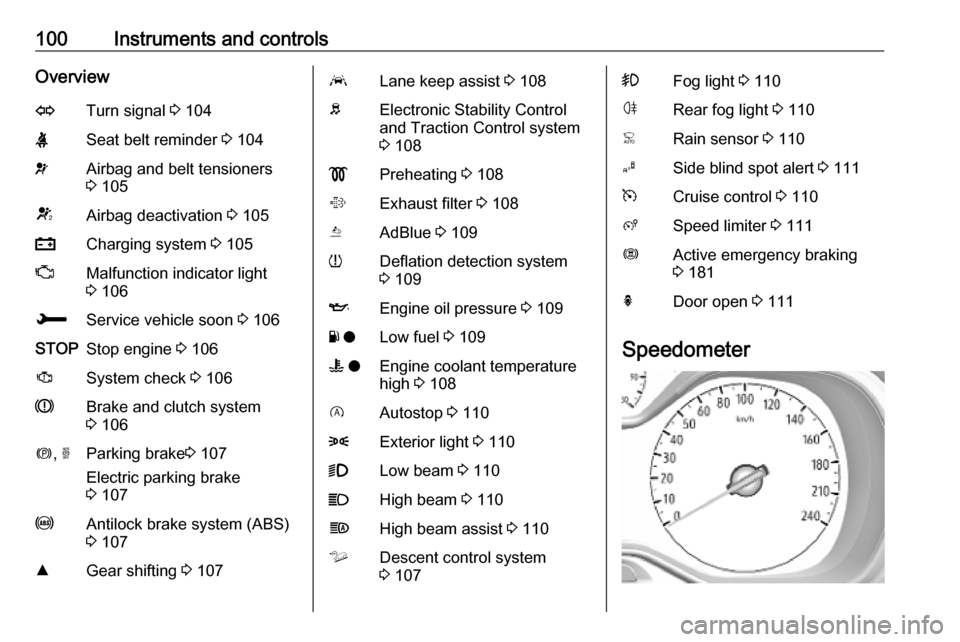brake sensor OPEL COMBO E 2019 Manual user
[x] Cancel search | Manufacturer: OPEL, Model Year: 2019, Model line: COMBO E, Model: OPEL COMBO E 2019Pages: 279, PDF Size: 10.43 MB
Page 89 of 279

Storage87To fasten a roof rack, open the caps
in the roof shown in the picture. Insert
the mounting provisions, as
instructed, in the retainer.
Vehicles without roof railing
To fasten a roof rack, open the caps
in the roof strips. Insert the mounting
provisions, as instructed, in the
retainer.
Loading information
● Heavy objects in the load compartment should be placed
against the seat backrests. Make
sure that the backrests are
securely engaged. If objects can
be stacked, heavier objects
should be placed at the bottom.
● Prevent sliding of loose objects by securing them with straps
attached to the lashing eyes
3 80.
● Do not allow the load to protrude above the upper edge of the
backrests.
● Do not place any objects on the rear luggage cover or the
instrument panel, and do not cover the sensor on top of theinstrument panel.
● The load must not obstruct the operation of the pedals, parking
brake and gear selector, or
hinder the freedom of movement
of the driver. Do not place any
unsecured objects in the interior.
● Do not drive with an open load compartment.9Warning
Always make sure that the load in
the vehicle is securely stowed.
Otherwise objects can be thrown
around inside the vehicle and
cause personal injury or damage
to the load or car.
● The payload is the difference between the permitted gross
vehicle weight (see identification
plate 3 254) and the EC kerb
weight.
Page 91 of 279

Instruments and controls89Instruments and
controlsControls ....................................... 90
Steering wheel adjustment ........90
Steering wheel controls .............90
Heated steering wheel ...............90
Horn ........................................... 91
Windscreen wiper and washer ..91
Rear window wiper and washer ...................................... 93
Outside temperature ..................93
Clock ......................................... 94
Power outlets ............................. 95
Inductive charging .....................96
Cigarette lighter ......................... 97
Ashtrays .................................... 97
Warning lights, gauges and indi‐ cators ........................................... 98
Instrument cluster ......................98
Speedometer ........................... 100
Odometer ................................ 101
Trip odometer .......................... 101
Tachometer ............................. 101
Fuel gauge .............................. 102
Engine coolant temperature gauge ..................................... 102Engine oil level monitor...........102
Service display ........................ 103
Control indicators ....................104
Turn lights ................................ 104
Seat belt reminder ...................104
Airbag and belt tensioners .......105
Airbag deactivation ..................105
Charging system .....................105
Malfunction indicator light ........106
Service vehicle soon ...............106
Stop engine ............................. 106
System check .......................... 106
Brake and clutch system .........106
Parking brake .......................... 107
Electric parking brake ..............107
Electric parking brake fault ......107
Antilock brake system (ABS) ...107
Gear shifting ............................ 107
Descent control system ...........107
Lane keep assist .....................108
Electronic Stability Control and Traction Control system .........108
Engine coolant temperature ....108
Preheating ............................... 108
Exhaust filter ............................ 108
AdBlue ..................................... 109
Deflation detection system ......109
Engine oil pressure ..................109
Low fuel ................................... 109
Autostop .................................. 110Exterior light............................ 110
High beam ............................... 110
Low beam ................................ 110
High beam assist .....................110
LED headlights ........................ 110
Front fog lights ......................... 110
Rear fog light ........................... 110
Rain sensor ............................. 110
Cruise control .......................... 110
Adaptive cruise control ............110
Vehicle detected ahead ...........111
Side blind spot alert .................111
Active emergency braking .......111
Speed limiter ........................... 111
Door open ................................ 111
Displays ..................................... 112
Driver Information Centre ........112
Info Display .............................. 114
Head-up display ......................116
Vehicle messages ......................118
Warning chimes .......................118
Battery voltage ........................ 118
Vehicle personalisation ..............119
Page 102 of 279

100Instruments and controlsOverviewOTurn signal 3 104XSeat belt reminder 3 104vAirbag and belt tensioners
3 105VAirbag deactivation 3 105pCharging system 3 105ZMalfunction indicator light
3 106HService vehicle soon 3 106STOPStop engine 3 106JSystem check 3 106RBrake and clutch system
3 106m , oParking brake 3 107
Electric parking brake
3 107uAntilock brake system (ABS)
3 107RGear shifting 3 107LLane keep assist 3 108bElectronic Stability Control
and Traction Control system
3 108!Preheating 3 108%Exhaust filter 3 108YAdBlue 3 109wDeflation detection system
3 109IEngine oil pressure 3 109Y oLow fuel 3 109W oEngine coolant temperature
high 3 108DAutostop 3 1108Exterior light 3 1109Low beam 3 110CHigh beam 3 110fHigh beam assist 3 110òDescent control system
3 107>Fog light 3 110øRear fog light 3 110
Speedometer
Page 176 of 279

174Driving and operatingthe windscreen and camera sensors
to detect the vehicles ahead. If no
vehicle is detected in the driving path, the adaptive cruise control will
behave like a conventional cruise
control.
The adaptive cruise control
automatically decelerates the vehicle
when approaching a slower moving
vehicle. It then adjusts the vehicle
speed to follow the vehicle ahead at
the selected following distance. The
vehicle speed increases or decreases
to follow the vehicle ahead, but will
not exceed the set speed. It may
apply limited braking with activated
brake lights.
If the vehicle ahead accelerates or changes lane, the adaptive cruise
control progressively accelerates the
vehicle to return to the stored set
speed. If the driver operates the turn
lights to overtake a slower vehicle, the adaptive cruise control allows the
vehicle to temporarily approach the
vehicle ahead to help passing it.
However, the set speed will never be
exceeded.The adaptive cruise control can store
set speeds for manual transmission.
If the vehicle ahead is moving too
slowly and the selected following
distance cannot be maintained
anymore, a warning chime is given
and a message is displayed in the
Driver Information Centre. The
message prompts the driver to take
back control of the vehicle. On
vehicles with automatic transmission, the system can brake the vehicle until a full stop.
The adaptive cruise control can store
set speeds over 30 km/h for manual
transmission. If the vehicle ahead is
moving too slowly and the selected
following distance cannot be
maintained anymore, a warning
chime is given and a message is
displayed in the Driver Information
Centre. The message prompts the driver to take back control of the
vehicle. On vehicles with automatic
transmission, the system can brake
the vehicle until a full stop.9 Warning
The complete driver attention is
always required while driving with adaptive cruise control. The driver stays fully in control of the vehicle
because the brake pedal, the
accelerator pedal and the button
Ñ have priority over any adaptive
cruise control operation.
Switching on the system
Press C, the symbol C is indicated in
the Driver Information Centre. The
system is still not active.
Page 183 of 279

Driving and operating1819Warning
Forward collision alert is just a
warning system and does not
apply the brakes. When
approaching a vehicle ahead too
rapidly, it may not provide you
enough time to avoid a collision.
The driver accepts full
responsibility for the appropriate
following distance based on traffic, weather and visibility conditions.
The complete attention of the
driver is always required while
driving. The driver must always be
ready to take action and apply the
brakes.
Caution
The colour lighting of this control
indicator does not correspond to
local traffic laws on following
distance. The driver bears full
responsibility for maintaining safe
following distance according to
applicable traffic rules, weather
and road conditions etc. at all
times.
Selecting the alert sensitivity
The alert sensitivity has to be set to
close, normal or distant in the vehicle personalisation menu 3 119.
The chosen setting will remain until it
is changed. The alert timing will vary
based on vehicle speed. The faster
the vehicle speed, the farther away
the alert will occur. Consider traffic
and weather conditions when
selecting the alert timing.
Deactivation The system can only be deactivated
by deactivating the active emergency
braking in the vehicle personalisation
3 119.
System limitations
Forward collision alert is designed to
warn on vehicles only, but may react
also to other objects.
In the following cases, forward
collision alert may not detect a vehicle ahead or sensor performance is
limited:
● driving on winding or hilly roads
● driving during nighttime
● weather limits visibility, such as fog, rain, or snow
● the sensor in the windscreen is blocked by snow, ice, slush, mud,dirt etc.
● the windscreen is damaged or affected by foreign objects, e.g.
stickers
Active emergency braking
Active emergency braking can help to reduce the damage and injury from
crashes with vehicles, pedestrians
and obstacles directly ahead, when a
collision can no longer be avoided
either by manual braking or by
steering. Before the active
emergency braking applies, the driver is warned by the forward collision
alert 3 180 or the front pedestrian
protection alert 3 184.
Page 184 of 279

182Driving and operatingThe feature uses various inputs (e.g.
camera sensor, brake pressure,
vehicle speed) to calculate the
probability of a frontal collision.9 Warning
This system is not intended to
replace the driver responsibility for driving the vehicle and looking
ahead. Its function is limited to
supplemental use only to reduce
the vehicle speed before a
collision.
The system may not react to
animals. After a sudden lane
change, the system needs a
certain time to detect the next
preceding vehicle.
The driver must always be ready
to take action and apply the brakes and steer to avoid collisions.
Operation conditions
Active emergency braking is
equipped with a front camera and
operates in forward gear above
walking speed up to 85 km/h. The
system detects stationary vehicles
only if the speed does not exceed
80 km/h.
Activation A precondition is that forward collision
alert with front camera system is not
deactivated in the vehicle
personalisation menu 3 119.
Functionality The system includes: ● emergency automatic braking
● forward looking brake assist ● forward collision alert
● front pedestrian protection
Emergency automatic braking
After activation of brake preparation
system and just before the imminent
collision, this function automatically
applies limited braking to reduce theimpact speed of the collision or
prohibit a crash. If active emergency
braking is applied, m flashes in the
instrument cluster. Depending on the
situation, the vehicle may
automatically brake moderately or
hard. This front automatic braking can
only occur if a vehicle 3 180 or a
pedestrian 3 184 ahead is detected.
Emergency automatic braking may slow the vehicle to a complete stop to
try to avoid a potential crash.
● Automatic transmission: If the vehicle comes to a complete
stop, automatic braking is
maintained for up to two
seconds. Keep the brake pedal
depressed to prevent the vehicle
from starting off again.
● Manual transmission: If the vehicle comes to a complete
stop, the engine may stall.
Operation of the function may be felt
by a slight vibration in the brake
pedal.
Page 189 of 279

Driving and operating187Activation
In addition to the rear parking assist,
the front parking assist is triggered
when an obstacle is detected in front
and the speed of the vehicle is below 10 km/h.
Graphic Info Display: The system is
ready to operate when the LED in the
parking assist button ¼ is not
illuminated.
Colour Info Display: Activate the
parking assist is in the 3 119.
Indication
The system warns the driver with
acoustic signals against potentially
hazardous obstacles in front of the
vehicle and behind the vehicle.
Depending on which side of the
vehicle is closer to an obstacle, you
will hear acoustic warning signals in
the vehicle on the respective side.
The interval between the sounds
becomes shorter as the vehicle gets closer to that obstacle. When the
distance is less than approx. 30 cm,
the sound is continuous.
Additionally, the distance to rear and
front obstacles is displayed by
changing distance lines in the Info Display 3 114.
If the vehicle stops for more than
three seconds in a forward gear, if
automatic transmission is in P or if no
further obstacles are detected, no
acoustic warning signals are given.
Deactivation
The system is deactivated
automatically when vehicle speed
exceeds 10 km/h, by applying the
electric parking brake or by pressing
the parking assist button ¼.
Graphic Info Display: The system is
switched off when the LED in the
parking assist button ¼ is illuminated.
Colour Info Display: Deactivate the
parking assist in the 3 119.
Front-rear-lateral parking assist
The front-rear-lateral parking parking
assist measures the distance
between the vehicle and obstacles in
front, behind and at the sides of the
vehicle. It informs and warns the
driver by giving acoustic signals and
display indication.
The system operates with ultrasonic parking sensors in the rear and front
bumper and on the flanks of the
vehicle.
Activation
In addition to the rear parking assist
and the front-rear assist, the front-
rear-lateral parking assist is triggered when the system detects fixed
obstacles located to one or both sides
of the vehicle.
Page 270 of 279

268Customer informationVehicle data recording
and privacy
Event data recorders
Electronic control units are installed in
your vehicle. Control units process
data which is received by vehicle
sensors, for example, or which they
generate themselves or exchange
amongst themselves. Some control
units are necessary for the safe
functioning of your vehicle, others
assist you while you drive (driver
assistance systems), while others
provide comfort or infotainment
functions.
The following contains general
information about data processing in
the vehicle. You will find additional
information as to which specific data
is uploaded, stored and passed on to third parties and for what purpose in
your vehicle under the key word Data Protection closely linked to the
references for the affected functional
characteristics in the relevant owner's manual or in the general terms of
sale. These are also available online.Operating data in the vehicle
Control units process data for
operation of the vehicle.
This data includes, for example: ● vehicle status information (e.g. speed, movement delay, lateral
acceleration, wheel rotation rate,
"seat belts fastened" display)
● ambient conditions (e.g. temperature, rain sensor,
distance sensor)
As a rule such data is transient and is
not stored for longer than an
operational cycle, and only processed on board the vehicle itself. Often
control units include data storage
(including the vehicle key). This is
used to allow information to be
documented temporarily or
permanently on vehicle condition,
component stress, maintenance
requirements and technical events
and errors.Depending on technical equipment
levels, the data stored is as follows:
● system component operating states (e.g. fill level, tyre
pressure, battery status)
● faults and defects in important system components (e.g. lights,
brakes)
● system reactions in special driving situations (e.g. triggering
of an airbag, actuation of the
stability control systems)
● information on events damaging the vehicle
● for electric vehicles the amount of
charge in the high-voltage
battery, estimated range
In special cases (e.g. if the vehicle
has detected a malfunction), it may be
necessary to save data that would
otherwise just be volatile.
When you use services (e.g. repairs,
maintenance), the operating data
saved can be read together with the
vehicle identification number and
used where necessary. Staff working
for the service network ( e.g. garages,
manufacturers) or third parties (e.g.
Page 277 of 279

275PPanoramic view system ..............195
Parking ................................ 20, 151
Parking assist ............................ 185
Parking brake ..................... 107, 161
Parking heater ............................ 139
Parking lights ............................. 127
Particulate filter ........................... 152
Performing work ........................212
Peripheral lighting .......................130
Power button .............................. 145
Power outlets ............................... 95
Power saving mode ....................146
Power windows ............................ 41
Preheating ................................. 108
Puncture ..................................... 238
R
Radio Frequency Identification (RFID) ..................................... 271
Radio remote control ...................22
Rain sensor ................................ 110
REACH ....................................... 267
Reading lights ............................ 128
Rear doors ................................... 31
Rear fog light .............110, 126, 222
Rear view camera ...................... 197
Rear windows .............................. 43
Rear window wiper and washer ..93Recommended fluids and
lubricants ........................ 252, 256
Refuelling ................................... 204
Registered trademarks ...............267
Removing seats ............................ 53
Reversing lights .........................127
Ride control systems ..................164
Roller blinds ................................. 44
Roof .............................................. 45
Roof load ...................................... 87
Roof panelling .............................. 75
Roof rack ..................................... 86
S Safety net .................................... 81
Seat adjustment ....................... 7, 48
Seat belt ........................................ 8
Seat belt reminder .....................104
Seat belts ..................................... 56
Seat folding .................................. 49
Seat heating ................................. 51
Seat position ................................ 47
Second row seats ........................52
Selective catalytic reduction .......153
Selective ride control ..................167
Selector lever ............................. 157
Service ............................... 142, 250
Service display .......................... 103
Service information ....................250
Service vehicle soon .................. 106Side airbag system ......................62
Side blind spot alert ............111, 193
Sidelights .................................... 122
Side turn lights ........................... 224
Sliding door .................................. 30
Sliding side door ........................... 30
Spare wheel ............................... 238
Speed limiter....................... 111, 171
Speedometer ............................. 100
Starting and operating ................144
Starting off ................................... 18
Starting the engine ....................147
Steering ...................................... 144
Steering wheel adjustment ......9, 90
Steering wheel controls ...............90
Stop engine ................................ 106
Stop-start system........................ 148
Storage ......................................... 71
Storage compartments .................71
Sunvisor lights ........................... 128
Sun visors .................................... 44
Symbols ......................................... 4
System check ............................. 106
T
Tachometer ............................... 101
Tailgate ......................................... 33
Tail lights ................................... 222
Third row seats ............................ 53
Three-point seat belt .................... 57